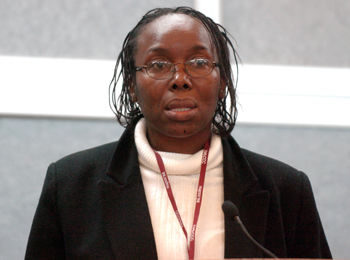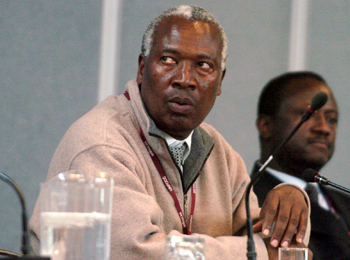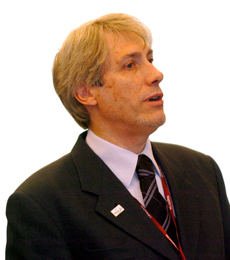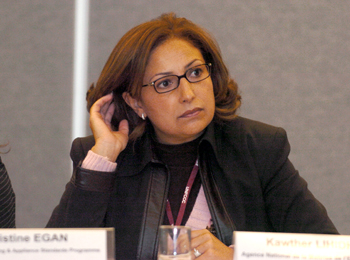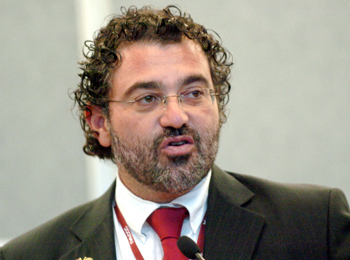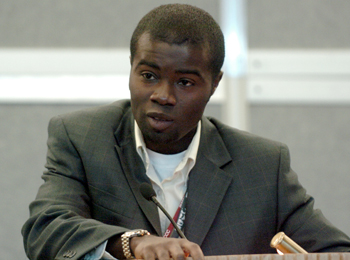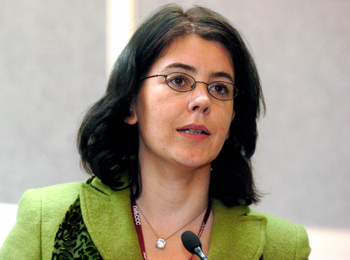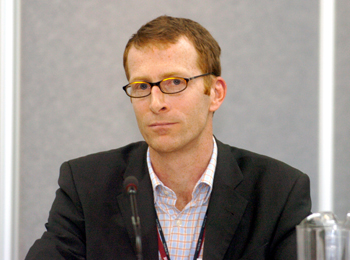 |
||
|
published by IISD, the International Institute for Sustainable Development
in cooperation with the UNFCCC Secretariat. |
|||
|
Special Report on Selected Side Events at COP 11 & Kyoto Protocol COP/MOP 1
|
|||||
| 28 November - 9 December 2005 | Montréal, Canada | |||||
|
GEF assistance to address adaptation: the strategic priority on adaptation, the LDCF and the SCCF Presented by GEF |
|||
|
Richard Hosier, GEF, called for enhancing the exchange of lessons learned from adaptation activities.
Bonizella Biagini, GEF, explained that through the Least Developing Country Fund (LDCF), the Special Climate Change Fund (SCCF) and the Adaptation Fund, the GEF helps to raise countries’ awareness of their vulnerabilities and build adaptive capacity. She stressed the project proponent has to demonstrate that impacts of climate change impose an additional cost on vulnerable countries in achieving their development goals. She listed the approved projects, as well as those in the pipeline, noting the approval of the first three SCCF projects. Ratemo Michieka, National Environment Management Authority, Kenya, described a UNDP/GEF project on coping with drought and climate change aimed at improving the capacity of communities to cope with climate pressures and ensuring ecosystem resilience. He outlined the expected project outcomes, including: piloting coping strategies; improving early warning information flows; implementing drought preparedness and mitigation policies; and replicating and disseminating lessons learned. Margaret Sangarwe, Ministry of Environment and Tourism, Zimbabwe, described a GEF project aimed at enhancing the adaptation capacity in agricultural and pastoral systems. She explained the project is currently at the formulation stage, stressing that stakeholder participation is crucial. She listed current maladaptive coping strategies such as denial of education, crime, deforestation, and wild life poaching. She emphasized that expenditure on drought relief and recovery has become substantial, however assistance has not enhanced community capacity to deal with future droughts. Ietitaia Setu Taule’alo, Ministry of Natural Resources and Environment, Samoa, said his country is one of the four selected by UNDP/GEF to implement its community-based adaptation programme. He indicated that the project aims at developing a framework to respond to community-based needs and mainstream lessons learned. Alexandre Cabral, Ministry of Natural Resources, Guinea Bissau, described a project on adaptation to climate and coastal changes in five west African countries affected by erosion, disappearance of mangroves, sea level rise and sand mining. He said the objective is to carry out pilot protection actions such as mangrove plantation in priority sites to demonstrate adaptation measures and formulate adaptation strategies in coastal areas. Discussion: participants addressed difficulties in calculating the additional cost related to adaptation, and mixing traditional with modern techniques for early warning systems. |
|||
|
|||
|
||||||||||||||||||||||||||||||||||||||||||||||||||
|
|||
|
|
|||
|
The Global Climate Observing System: a focus on regional activities Presented by the World Meteorological Organization |
|||||||
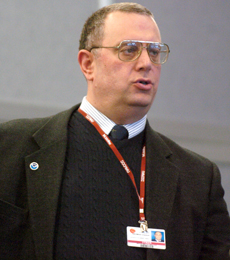 |
William Westermeyer, Global Climate Observation System (GCOS), described the status and future direction of the GCOS Regional Workshop Programme, reviewed some of their recommendations, and identified related COP decisions. He outlined the Regional Action Plan for South and Southwest Asia and called for data rescue, integration of historical data and more GCOS Surface Network (GSN) stations.
Howard Diamond, US National Oceanic and Atmospheric Administration, provided an overview of the GCOS System Improvement Programme and commended the improved Global System Information Center website. He described the Pacific Island Global Observing System’s objective of enhancing Pacific Climate Observations. Paul Mason, GCOS Steering Committee, described the Cooperation Mechanism and the SBSTA’s proposals for an improved funding mechanism. Joan Fitzpatrick, Group on Earth Observations (GEO), described the GEO and the Global Earth Observation System of Systems. |
||||||
| Howard Diamond, NOAA, describes some of the technical support missions to GSN stations | |||||||
 |
|||||||
| L-R: Howard Diamond, NOAA, Paul Masen, Chair GCOS Stearing Committee, and Joan Fitzpatrick, GEO Secretariat | |||||||
|
|||
|
Unikkaaqatigiit-Book Launch Presented by Inuit Tapiriit Kanatami |
|||||||
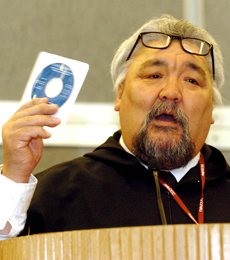 |
Steven Hendrie, Inuit Tapiriit Kanatami, noted the launch of the book titled “Unikkaaqatigiit-Putting a Human Face on Climate Change”.
Jose Kusugak, President, Inuit Tapiriit Kanatami, said the book describes how the Inuit are affected by climate change, their adaptation efforts, and future adaptation needs. He underscored the importance of incorporating cultural and local knowledge components into adaptation strategies. Mucktar Akumalik, Arctic Bay, Nunavut, highlighted that the decrease and late arrival of snow in his community had caused numerous economic hardships. Naalak Nappaluk, Kangiqsujuak, Nunavik, highlighted a number of effects of climate change on his community such as a decease in traditional food sources and health problems. Pauline Anderson, Northwest River, Nunatsiavut, outlined the changes taking place in his community due to climate change such as the decreased availability of plant and animal food and loss of traditional snow travel routes. |
||||||
| Jose Kusugak, Inuit Tapiriit Kanatami, stated that if we can put a man on the moon, we can fix the Arctic | |||||||
|
John Keogak, Sachs Harbour, Inuvialuit, explained that the impacts of climate change has caused a devastating impact on the region, including the loss of many cultural sites, and has required the relocation of entire communities. Discussion: participants discussed the effects of climate change on indigenous communities and the need to consider adaptation in terms of sustainable livelihoods as well as technology transfer. |
|||||||
|
|||
|
A Southern-led approach to tackling climate change and poverty Presented by SouthSouthNorth |
|||||
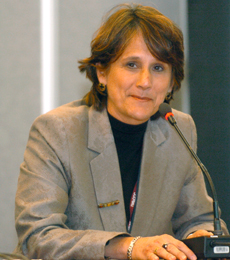 |
Rod Janssen, Helio International, said SouthSouthNorth (SSN) carries out adaptation, capacity building, technology transfer and policy programmes.
Emilio La Rovere, Centro Clima, said SSN’s approach utilizes CDM to create projects that maximize sustainable development. He described a solid waste incineration project in Brazil, saying the project is cost effective and contributes to environmental sustainability. Steve Thorne, SouthSouthNorth, described the Kuyasa project, which upgrades low cost housing, as delivering high sustainable development benefits. He highlighted lessons learned, including that although projects with many beneficiaries may be process heavy, they provide security and ownership co-benefits. He added that the Gold Standard programme can deliver sustainable development benefits. On capacity development for CDM in the South, Thais Corral, Human Development Network (REDEH), said they are developing institutional capacity, capacity of their partners, and southern capacity, in order to pursue structural poverty reduction; deliver projects to mitigate global GHG emissions, and assist communities in adapting to climate change. On adaptation, Saleemul Huq, International Institute for Environment and Development, introduced the SSNs new adaptation methodology, an adaptation project protocol for community-based adaptation. |
||||
| Thais Corral, Human Development Network (REDEH), highlighted benefits SSN hopes to achieve through projects, including: clean water for household consumption and sanitation; increased funds for education; reducing exposure to indoor pollution; and safe neighborhoods | |||||
| Discussion: participants discussed replicability of projects in the private sector and the questionable merits of solid waste incineration. | |||||
|
|||
|
The Austrian JI/CDM Programme Presented by Austria |
|||
|
Christopher Lamport, Ministry of Environment, Austria, described Austria’s climate strategy, and noted that flexible mechanisms such as JI and CDM have played a major role towards the target of reducing emissions by 13%. He indicated that focus project categories include combined heat and power, energy efficiency, and landfill gas.
Alexandra Amerstorfer, Kommunalkredit, Austria, stressed the importance of including small-scale projects in their CDM portfolio, and encouraged the submission of eligible projects, particularly those that: fall within the priority categories; have a detailed business plan; demonstrate financial feasibility; and hold potential for regional development. She said the negotiation of a contract is based on market price, but that factors such as risk and project quality are also relevant. She added that project pre-payment of up to 30% may be possible. She indicated that 110 projects are in the pipeline, and noted the emerging importance of the Indian and Chinese markets for CDM projects. |
|||
|
|||
|
Asian Concerns on the Climate Regime Beyond 2012: Are You Concerned? Presented by the Institute for Global Environmental Strategies |
||||||||
| Akio Morishima, Institute for Global Environmental Strategies (IGES), stated that Asian perspectives are not adequately addressed in the Kyoto Protocol and explained that IGES’ policy dialogue aims at surveying the opinion of Asian stakeholders on the post 2012 regime.
Bert Metz, Environmental Assessment Agency, the Netherlands, underlined the importance of stakeholder involvement in understanding interests and values, and build realistic consensus on realistic alternatives. Ancha Srinivasan, IGES, outlined the interests that emerged from the IGES dialogues on the climate regime beyond 2012, including streamling the CDM and facilitating technology transfer, and noted country differences in priority areas. Hironori Hamanaka, Keio University, suggested utilization of market pull approaches, efficiency standards for electric appliances, emissions trading and other market-based mechanisms. Xuedu Lu, Chinese Academy of Science and Technology, said making more efficient technology available would achieve large scale emissions reductions at a low cost. |
||||||||
 |
||||||||
| Akio Morishima, IGES Board Chairman, said the objectives of these consultations was to ascertain the concerns, interests and priorities of countries in relation to the future climate regime | ||||||||
|
S. K. Joshi, Ministry of Environment and Forests, India, called for a focus on enabling environments and adaptive research. Jyoti Parikh, Integrated Research and Action for Development, noted that emissions and adaptive needs do not correlate. Liana Bratiasida, Ministry of Environment, Indonesia, said the Kyoto Protocol must be extended in order to have credibility in the multilateral process. Tae Yong Jung, IGES, called for focusing on joint technology initiatives rather than on technology transfer. |
||||||||
|
|||
|
||
|
Click the above button to go back to our ENB main coverage
|
||
|
|
|
|
|
||
|



